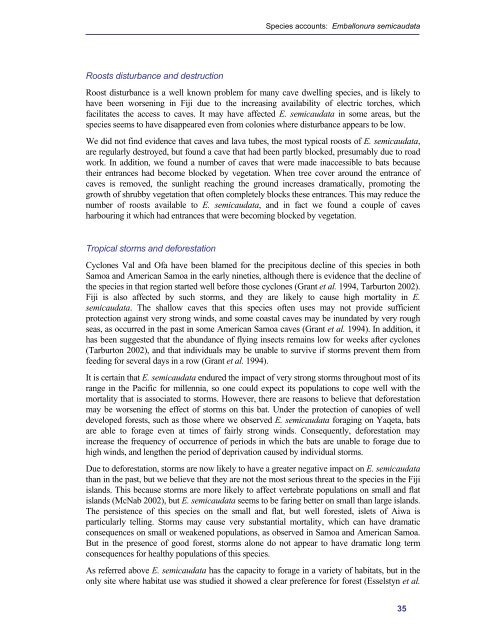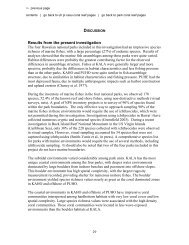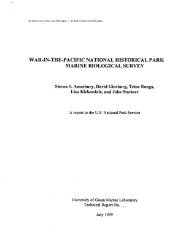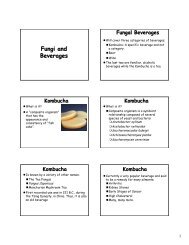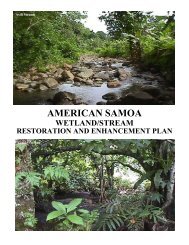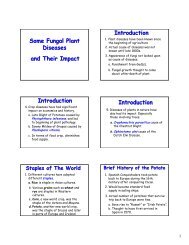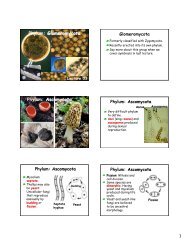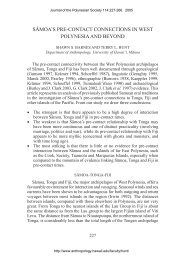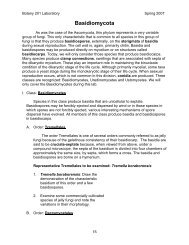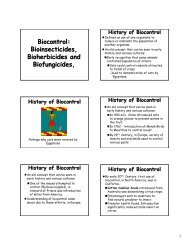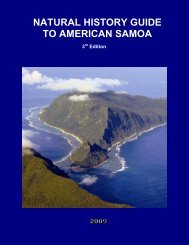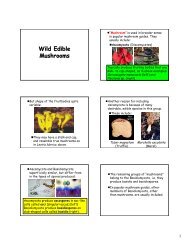distribution, status, and conservation of bats in the fiji islands
distribution, status, and conservation of bats in the fiji islands
distribution, status, and conservation of bats in the fiji islands
Create successful ePaper yourself
Turn your PDF publications into a flip-book with our unique Google optimized e-Paper software.
Species accounts: Emballonura semicaudata<br />
Roosts disturbance <strong>and</strong> destruction<br />
Roost disturbance is a well known problem for many cave dwell<strong>in</strong>g species, <strong>and</strong> is likely to<br />
have been worsen<strong>in</strong>g <strong>in</strong> Fiji due to <strong>the</strong> <strong>in</strong>creas<strong>in</strong>g availability <strong>of</strong> electric torches, which<br />
facilitates <strong>the</strong> access to caves. It may have affected E. semicaudata <strong>in</strong> some areas, but <strong>the</strong><br />
species seems to have disappeared even from colonies where disturbance appears to be low.<br />
We did not f<strong>in</strong>d evidence that caves <strong>and</strong> lava tubes, <strong>the</strong> most typical roosts <strong>of</strong> E. semicaudata,<br />
are regularly destroyed, but found a cave that had been partly blocked, presumably due to road<br />
work. In addition, we found a number <strong>of</strong> caves that were made <strong>in</strong>accessible to <strong>bats</strong> because<br />
<strong>the</strong>ir entrances had become blocked by vegetation. When tree cover around <strong>the</strong> entrance <strong>of</strong><br />
caves is removed, <strong>the</strong> sunlight reach<strong>in</strong>g <strong>the</strong> ground <strong>in</strong>creases dramatically, promot<strong>in</strong>g <strong>the</strong><br />
growth <strong>of</strong> shrubby vegetation that <strong>of</strong>ten completely blocks <strong>the</strong>se entrances. This may reduce <strong>the</strong><br />
number <strong>of</strong> roosts available to E. semicaudata, <strong>and</strong> <strong>in</strong> fact we found a couple <strong>of</strong> caves<br />
harbour<strong>in</strong>g it which had entrances that were becom<strong>in</strong>g blocked by vegetation.<br />
Tropical storms <strong>and</strong> deforestation<br />
Cyclones Val <strong>and</strong> Ofa have been blamed for <strong>the</strong> precipitous decl<strong>in</strong>e <strong>of</strong> this species <strong>in</strong> both<br />
Samoa <strong>and</strong> American Samoa <strong>in</strong> <strong>the</strong> early n<strong>in</strong>eties, although <strong>the</strong>re is evidence that <strong>the</strong> decl<strong>in</strong>e <strong>of</strong><br />
<strong>the</strong> species <strong>in</strong> that region started well before those cyclones (Grant et al. 1994, Tarburton 2002).<br />
Fiji is also affected by such storms, <strong>and</strong> <strong>the</strong>y are likely to cause high mortality <strong>in</strong> E.<br />
semicaudata. The shallow caves that this species <strong>of</strong>ten uses may not provide sufficient<br />
protection aga<strong>in</strong>st very strong w<strong>in</strong>ds, <strong>and</strong> some coastal caves may be <strong>in</strong>undated by very rough<br />
seas, as occurred <strong>in</strong> <strong>the</strong> past <strong>in</strong> some American Samoa caves (Grant et al. 1994). In addition, it<br />
has been suggested that <strong>the</strong> abundance <strong>of</strong> fly<strong>in</strong>g <strong>in</strong>sects rema<strong>in</strong>s low for weeks after cyclones<br />
(Tarburton 2002), <strong>and</strong> that <strong>in</strong>dividuals may be unable to survive if storms prevent <strong>the</strong>m from<br />
feed<strong>in</strong>g for several days <strong>in</strong> a row (Grant et al. 1994).<br />
It is certa<strong>in</strong> that E. semicaudata endured <strong>the</strong> impact <strong>of</strong> very strong storms throughout most <strong>of</strong> its<br />
range <strong>in</strong> <strong>the</strong> Pacific for millennia, so one could expect its populations to cope well with <strong>the</strong><br />
mortality that is associated to storms. However, <strong>the</strong>re are reasons to believe that deforestation<br />
may be worsen<strong>in</strong>g <strong>the</strong> effect <strong>of</strong> storms on this bat. Under <strong>the</strong> protection <strong>of</strong> canopies <strong>of</strong> well<br />
developed forests, such as those where we observed E. semicaudata forag<strong>in</strong>g on Yaqeta, <strong>bats</strong><br />
are able to forage even at times <strong>of</strong> fairly strong w<strong>in</strong>ds. Consequently, deforestation may<br />
<strong>in</strong>crease <strong>the</strong> frequency <strong>of</strong> occurrence <strong>of</strong> periods <strong>in</strong> which <strong>the</strong> <strong>bats</strong> are unable to forage due to<br />
high w<strong>in</strong>ds, <strong>and</strong> leng<strong>the</strong>n <strong>the</strong> period <strong>of</strong> deprivation caused by <strong>in</strong>dividual storms.<br />
Due to deforestation, storms are now likely to have a greater negative impact on E. semicaudata<br />
than <strong>in</strong> <strong>the</strong> past, but we believe that <strong>the</strong>y are not <strong>the</strong> most serious threat to <strong>the</strong> species <strong>in</strong> <strong>the</strong> Fiji<br />
isl<strong>and</strong>s. This because storms are more likely to affect vertebrate populations on small <strong>and</strong> flat<br />
isl<strong>and</strong>s (McNab 2002), but E. semicaudata seems to be far<strong>in</strong>g better on small than large isl<strong>and</strong>s.<br />
The persistence <strong>of</strong> this species on <strong>the</strong> small <strong>and</strong> flat, but well forested, islets <strong>of</strong> Aiwa is<br />
particularly tell<strong>in</strong>g. Storms may cause very substantial mortality, which can have dramatic<br />
consequences on small or weakened populations, as observed <strong>in</strong> Samoa <strong>and</strong> American Samoa.<br />
But <strong>in</strong> <strong>the</strong> presence <strong>of</strong> good forest, storms alone do not appear to have dramatic long term<br />
consequences for healthy populations <strong>of</strong> this species.<br />
As referred above E. semicaudata has <strong>the</strong> capacity to forage <strong>in</strong> a variety <strong>of</strong> habitats, but <strong>in</strong> <strong>the</strong><br />
only site where habitat use was studied it showed a clear preference for forest (Esselstyn et al.<br />
35


